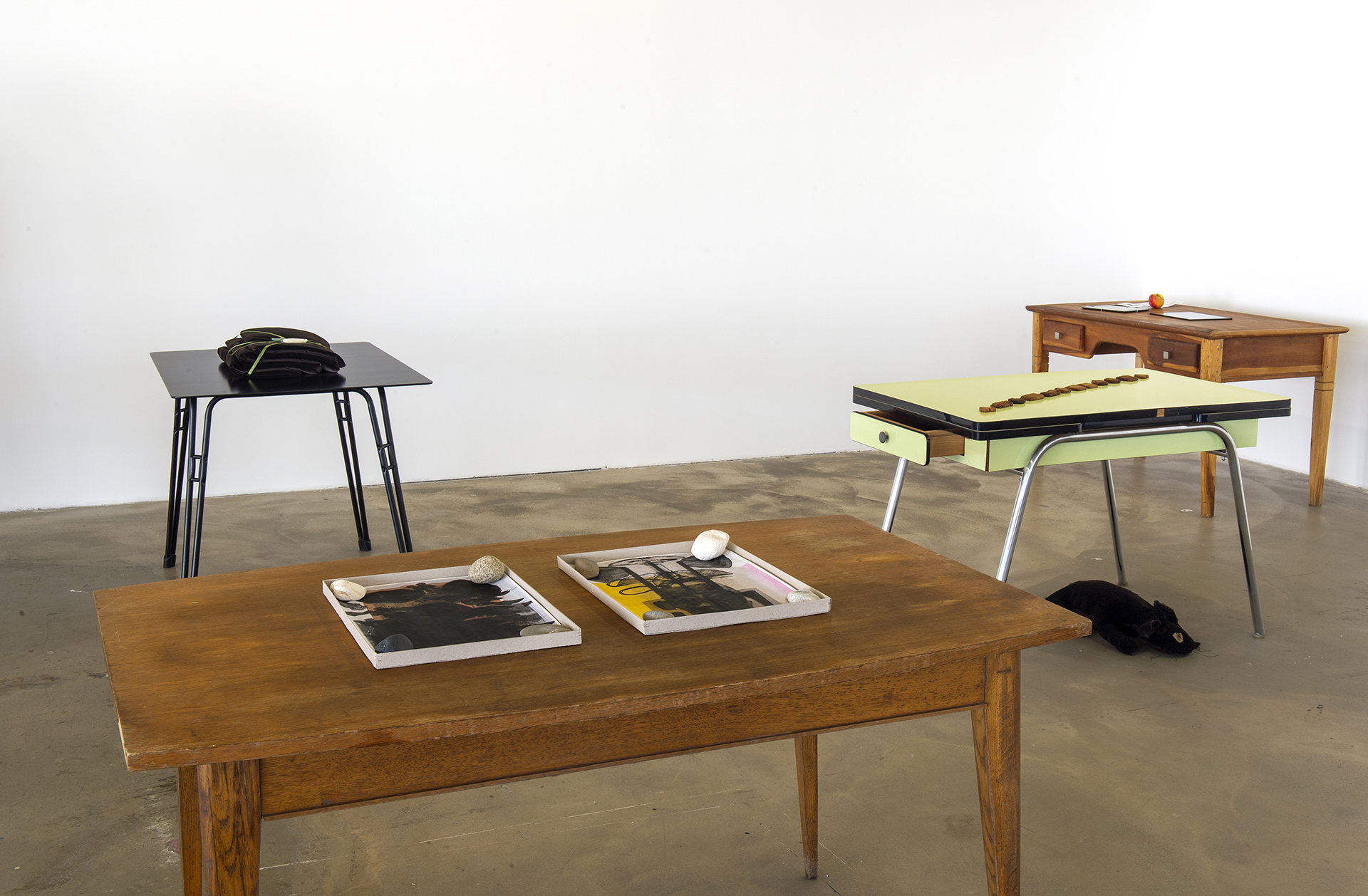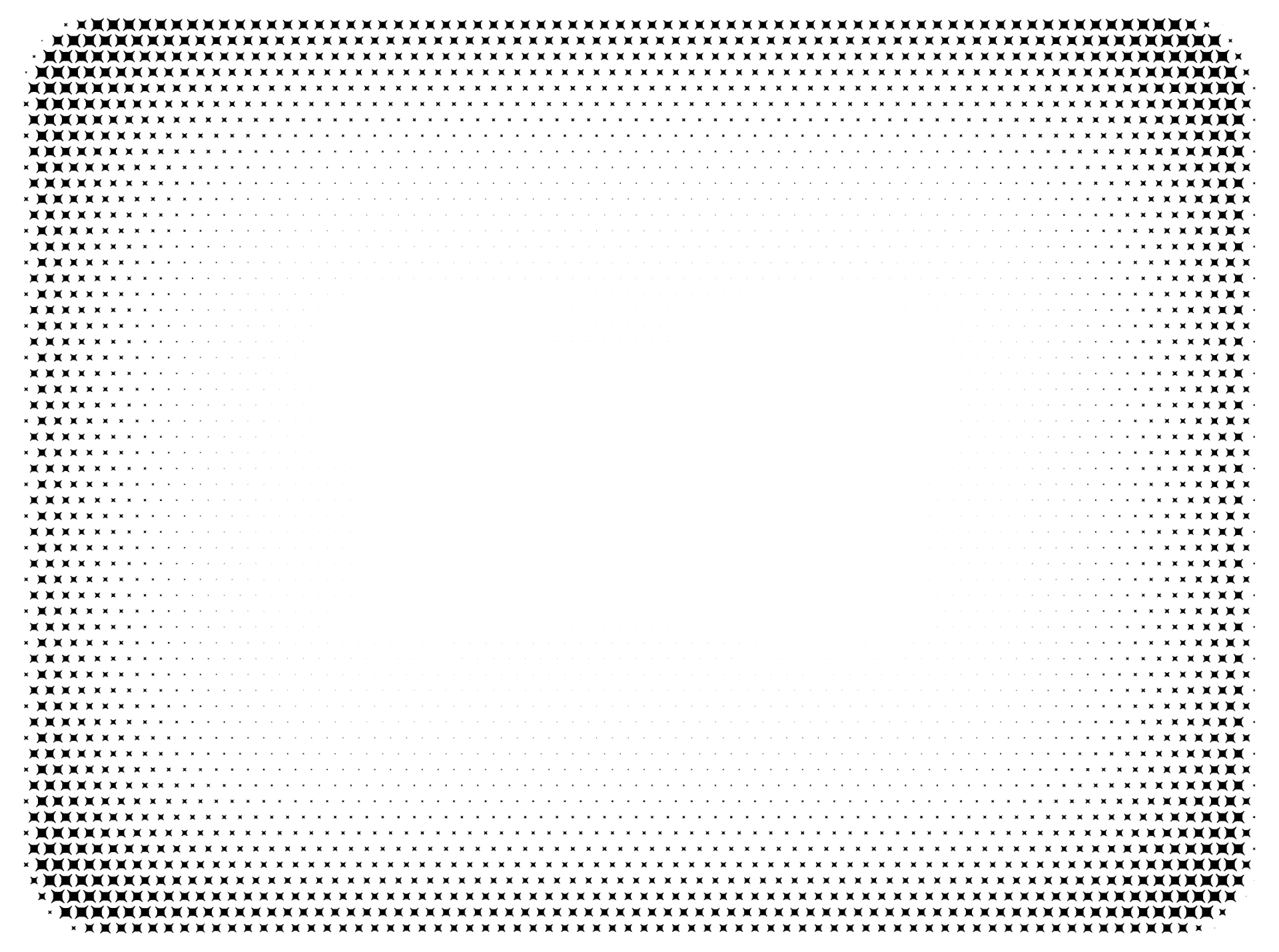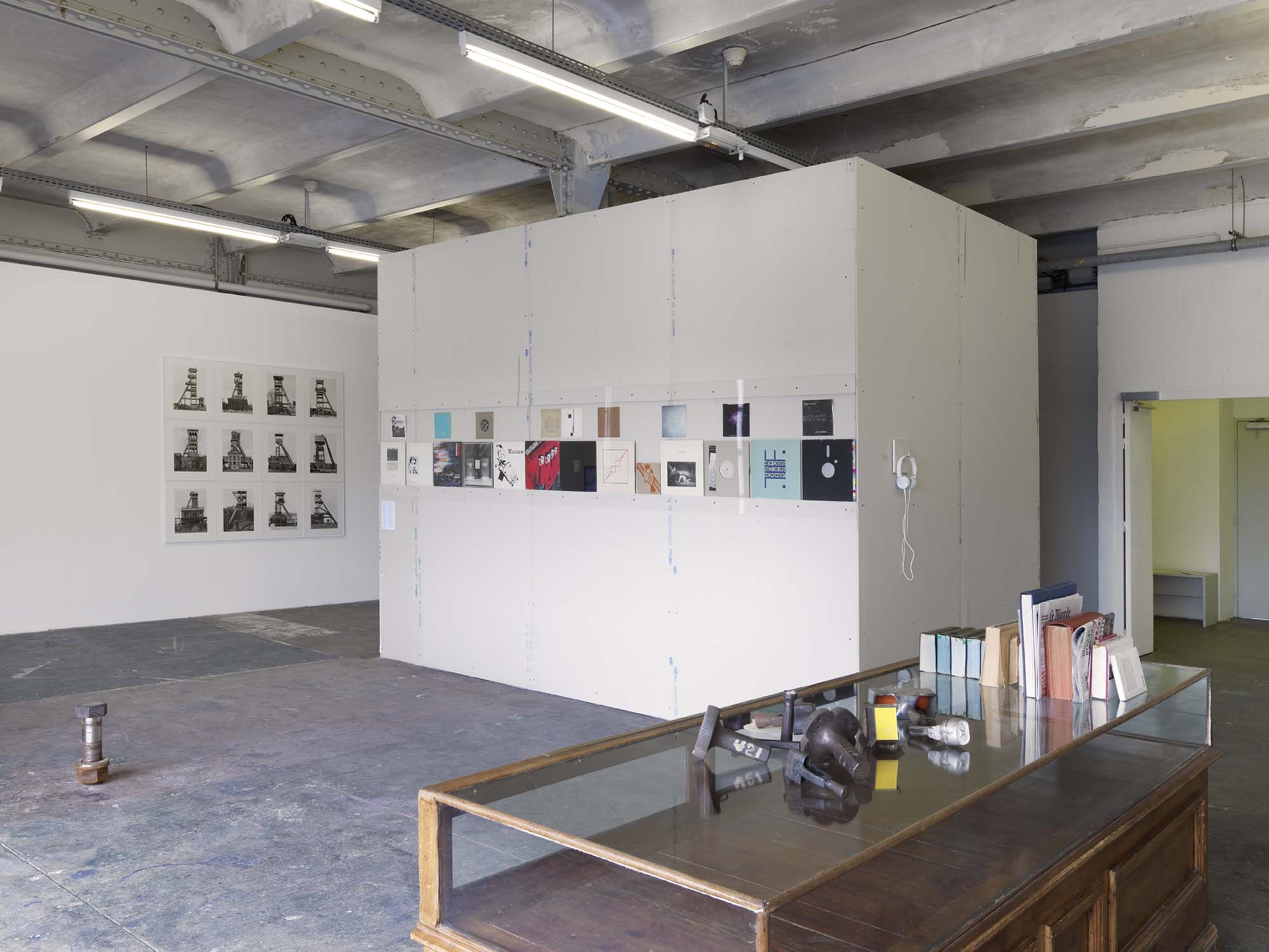L’Iguane
Louise Hervé & Clovis Maillet

Louise Hervé & Chloé Maillet, vue de l’exposition L’Iguane, Centre d’art contemporain d’Ivry – le Crédac, 2018. Louise Hervé & Chloé Maillet, Imitation d’Annie Besant, Formes-pensées - le soir de la première (sous l’influence de M.D.P.) 2017 ; Collection LaM - Lille Métropole Musée d’art moderne, d’art contemporain et d’art brut, Villeneuve d’Ascq : Fleury Joseph Crépin, Tableau n°106, 1940 ; Tableau n°157, 1941 ; Augustin Lesage, Sans titre, vers 1952. © Photo : André Morin / le Crédac. © Louise Hervé & Chloé Maillet / ADAGP, Paris, 2017. Courtesy Marcelle Alix, Paris.

Louise Hervé & Chloé Maillet, vue de l’exposition L’Iguane, Centre d’art contemporain d’Ivry – le Crédac, 2018. Photo : André Morin / le Crédac. De gauche à droite et de haut en bas : Louise Hervé & Chloé Maillet, Imitation d’Elise Müller (sous l’influence de C.B.), 2017 ; Alexandro Garcia, El cuadrado, 1980, Courtoisie christian berst art brut, Paris ; Madge Gill, Sans titre, 1923-1932, Collections Nathalie Gilles & Hugues Reip, Paris ; Louise Hervé & Chloé Maillet, Imitation d’Annie Besant, Formes-pensées – Inspiration intellectuelle (sous l’influence de M.D.P.), 2017 ; Henriette Zephir, Sans titre, 2008, Courtoisie christian berst art brut, Paris ; Louise Hervé & Chloé Maillet, L’Iguane - partie I, 2018. © Photo : André Morin / le Crédac. © Louise Hervé & Chloé Maillet / ADAGP, Paris, 2017. Courtesy Marcelle Alix, Paris.

Louise Hervé & Chloé Maillet, vue de l’exposition L’Iguane, Centre d’art contemporain d’Ivry – le Crédac, 2018. De gauche à droite : Louise Hervé & Chloé Maillet, Imitation d’Annie Besant, Formes-pensées - Pensées bienveillantes (sous l’influence de S.M.), 2017 ; Louise Hervé & Chloé Maillet, Imitation de Fleury Joseph Crépin (sous l’influence de M.M.), 2017 ; Alexandro Garcia, Ciudad Atlante, 2011, Courtoisie christian berst art brut, Paris ; Louise Hervé & Chloé Maillet, Imitation d’Annie Besant, Formes-pensées - Pensées bienveillantes (sous l’influence de S.M.), 2017. © Photo : André Morin / le Crédac. © Louise Hervé & Chloé Maillet / ADAGP, Paris, 2017. Courtesy Marcelle Alix, Paris.

Louise Hervé & Chloé Maillet, vue de l’exposition L’Iguane, Centre d’art contemporain d’Ivry – le Crédac, 2018. Anonyme (Archives Crépin), Pendule de Fleury Joseph Crépin, s.d. LaM - Lille Métropole Musée d’art moderne, d’art contemporain et d’art brut, Villeneuve d’Ascq. © Photo : André Morin / le Crédac. © Louise Hervé & Chloé Maillet / ADAGP, Paris, 2017. Courtesy Marcelle Alix, Paris.

Louise Hervé & Chloé Maillet, vue de l’exposition L’Iguane, Centre d’art contemporain d’Ivry – le Crédac, 2018. Louise Hervé & Chloé Maillet, Larry, 2015-2018. Imitation de gilet saint-simonien. Collection particulière. © Photo : André Morin / le Crédac. © Louise Hervé & Chloé Maillet / ADAGP, Paris, 2017. Courtesy Marcelle Alix, Paris.

Louise Hervé & Chloé Maillet, vue de l’exposition L’Iguane, Centre d’art contemporain d’Ivry – le Crédac, 2018. De gauche à droite : Larry, 2015-2018. Imitation de gilet saint-simonien. Collection particulière ; Nihil dictum quin prius dictum, 2013-2018. Tessons de marbre. © Photo : André Morin / le Crédac. © Louise Hervé & Chloé Maillet / ADAGP, Paris, 2017. Courtesy Marcelle Alix, Paris.

Louise Hervé & Chloé Maillet, vue de l’exposition L’Iguane, Centre d’art contemporain d’Ivry – le Crédac, 2018. Spectacles sans objet, 2014-2018 Disques vinyles, pochettes cartonnées faites main ; Diapositives, s8mm et vidéo HD transférés sur HD, 33 minutes Mobilier : Kalin Serapionov © Photo : André Morin / le Crédac. © Louise Hervé & Chloé Maillet / ADAGP, Paris, 2017. Courtesy Marcelle Alix, Paris.

Louise Hervé & Chloé Maillet, vue de l’exposition L’Iguane, Centre d’art contemporain d’Ivry – le Crédac, 2018. Louise Hervé & Chloé Maillet, Pythagore & les monstres, 2012. Film s8mm, 4 minutes 40 secondes, muet. © Photo : André Morin / le Crédac. © Louise Hervé & Chloé Maillet / ADAGP, Paris, 2017. Courtesy Marcelle Alix, Paris.

Louise Hervé & Chloé Maillet, vue de l’exposition L’Iguane, Centre d’art contemporain d’Ivry – le Crédac, 2018. Louise Hervé & Chloé Maillet, Un Projet important, 2009. Film 16mm et vidéo HD transférés sur vidéo HD, 38 minutes. © Photo : André Morin / le Crédac. © Louise Hervé & Chloé Maillet / ADAGP, Paris, 2017. Courtesy Marcelle Alix, Paris.

Louise Hervé & Chloé Maillet, vue de l’exposition L’Iguane, Centre d’art contemporain d’Ivry – le Crédac, 2018. © Photo : André Morin / le Crédac. © Louise Hervé & Chloé Maillet / ADAGP, Paris, 2017. Courtesy Marcelle Alix, Paris.

Louise Hervé & Chloé Maillet, vue de l’exposition L’Iguane, Centre d’art contemporain d’Ivry – le Crédac, 2018. Louise Hervé & Chloé Maillet, The Unnamed Room, 2017-2018. © Photo : André Morin / le Crédac. © Louise Hervé & Chloé Maillet / ADAGP, Paris, 2017. Courtesy Marcelle Alix, Paris.

Louise Hervé & Chloé Maillet, vue de la performance Larry, 2015-2018, Centre d’art contemporain d’Ivry – le Crédac, 2018.

Louise Hervé & Chloé Maillet, vue de la performance Le Phalanstère de Mars, 2015-2018, Centre d’art contemporain d’Ivry – le Crédac, 2018. © Les artistes / ADAGP, Paris, 2018. Courtesy Marcelle Alix, Paris.

Louise Hervé & Chloé Maillet, vue de la performance Nihil dictum quin prius dictum, 2013-2018, Centre d’art contemporain d’Ivry – le Crédac, 2018. Avec la participation d’Hélène Le Bihan. © Les artistes / ADAGP, Paris, 2018. Courtesy Marcelle Alix, Paris.

Louise Hervé & Chloé Maillet, vue de l’exposition L’Iguane, Centre d’art contemporain d’Ivry – le Crédac, 2018. Louise Hervé et Chloé Maillet, L’un de nous doit disparaître, 2012-2018. Fils du peuple (1949) de Maurice Thorez. Illustrations exécutées par le donateur Charles Rouquet, Section Cahors. Fonds Thorez-Vermeersch / Archives municipales Ivry-sur-Seine. © Photo : André Morin / le Crédac. © Louise Hervé & Chloé Maillet / ADAGP, Paris, 2017. Courtesy Marcelle Alix, Paris.

Louise Hervé & Clovis Maillet, vue de la performance L’Un de nous doit disparaître, 2012–2018. © Louise Hervé & Clovis Maillet / ADAGP, Paris, 2018.

Louise Hervé & Chloé Maillet, vue de l’exposition L’Iguane, Centre d’art contemporain d’Ivry – le Crédac, 2018. Louise Hervé et Chloé Maillet, L’un de nous doit disparaître, 2012-2018. Presse-papiers en métal. Cadeau des cellules J. Holtzer, Section Firminy. Fonds Thorez-Vermeersch / Archives municipales Ivry-sur-Seine. © Photo : André Morin / le Crédac. © Louise Hervé & Chloé Maillet / ADAGP, Paris, 2017. Courtesy Marcelle Alix, Paris.

Louise Hervé & Chloé Maillet, vue de la performance La Réponse, 2015-2018, Centre d’art contemporain d’Ivry – le Crédac, 2018. © Les artistes / ADAGP, Paris, 2018. Courtesy Marcelle Alix, Paris.


















Curatorship: Claire Le Restif and Sébastien Martins
• Act 1, The Unnamed Room (20.01–18.02)
• Act 2, Nothing Is Said (20.02–25.03)
« Time passes so slowly for me I think I shall last forever. » 1
Crédac’s regular visitors will recall Louise Hervé & Clovis Maillet from L’Homme de Vitruve (Vitruvian Man), the 2012 group show that also included the work of this artist duo. It was our first time working with the two and they exhibited a selection of objects that had once belonged to Maurice Thorez (leader of the French Communist Party from 1930 to 1964 and member of France’s National Assembly from Ivry). The collection is normally conserved in Ivry’s Municipal Archive. The man who entitled his autobiography Fils du Peuple (Son of the People) and claimed that the book was a tool for emancipation became the starting point of both a science fiction story, L’un de nous doit disparaître (One of Us Must Disappear) and a performance piece, which was produced by Crédac for the occasion.
Our interest in their work has not waned since and we have closely followed the direction their research has taken. The current invitation is premised on putting together an anthology-like exhibition to underscore the breadth and depth of the two artists’ creative process. Hervé and Maillet are presenting part of their latest undertaking while also revisiting a selection of their earlier pieces, which they have reconceived in new displays to show them in a different light. The duo wanted to articulate the show in two acts, La Salle sans nom (The Nameless Gallery) and Rien n’est dit (Nothing Is Said), comprising a retrospective program of medium-length films (part of Crédakino) and performances, which are scheduled for the exhibition’s entire run.
L’Iguane (The Iguana) is the display of a method. Is it because one of the artists is a graduate of the art school of Cergy and the other holds a doctorate in historical anthropology from EHESS that they go about imagining their work in a singular way? They explore episodes taken from history such as Pythagorean instruction, the holidays and fraternal songs of the Saint-Simonians, or the practice of jiu-jitsu by suffragettes, drawing from them points for thinking about the engines of social revolution and the ways knowledge is transmitted. These elements lend themselves well to being reenacted or reconstructed, and the artists combine them with fictional and historical narratives. Throughout there appears as well a genealogy of their own practice, along with a questioning of the present age.
The overall design of the display they have created recalls their “reasonable interest in the diorama” 2 and illusionistic devices that are animated by projected and synchronized images. The display elements they deploy suggest both the theater, in a concept in which actor and viewer share the same space, and mystery, through references to magic and esoteric initiations. And yet the two artists also leave the back of the decor on view for all to see and reserve certain concealed zones that open onto the landscape.
In a museum-like space, Louise Hervé & Clovis Maillet feature an imaginary collection of works that run from the early 20th century to today, which Fleury-Joseph Crépin, Madge Gill, Alexandro Garcia, and Augustin Lesage supposedly created under the influence of spirits and extraterrestrial entities that they maintained had lavished visions and technical advice on them. Hervé and Maillet also tried their hand at the same experience, producing facsimiles while guided by the kindly “spirits” of their entourage. This is in fact their latest project, developed in Northern France and Belgium. They have created links between Fourierist architecture, the spiritualist’s art, and a strange encounter with an iguana, the reptile that gives its name – an enigmatic title to say the least – to both the show and a film being shot at the time of the show, an initial threeminute excerpt of which is included in the exhibition.
An open window in the space affords us a glimpse of an unnamed room, a parallel area whose hidden door can only be entered by the public during performances. Isn’t this also a kind of staging that blurs the borders between the space of the illusion and what lies behind the scenes, scientific reconstruction and entertainment, knowledge and the marvelous?
For several years now Louise Hervé & Clovis Maillet have been conjuring up the iguana, whose relationship to time differs from ours. Through its eyes, retrospection can be anchored in the present as much as it can constitute a view that looks to the future. This antediluvian animal, almost stonelike with its usually slight, practically imperceptible movements, mirrors the artists’ interest in the living as a vestige of a time that is not altogether past.
« In a café near the port of Dunkirk lives an iguana. We met it a few years ago. We were staying in the youth hostel between the beach and the port, which was then hosting the annual illusion congress; dozens of magicians were rehearsing their acts, sporting amulets around their necks. We were the only people incapable of doing magic tricks. That evening we were eating at the café with a sailor. The iguana stared at us for a long time. It moved only a little, so precisely and slowly that our human gestures appeared disordered. The iguana moves in another dimension, we thought, where time is slowed down and perceptions are modified. Perhaps it is always living in the future. »3
Claire Le Restif & Sébastien Martins
Video(s)
Exhibition film directed by Florence Weyne Robert. © Le Crédac, 2018.
Documents
Artist biography
-
Louise Hervé & Clovis Maillet (born in 1981) work as a duo under the I.I.I.I.(International Institute for Important Items) entity, created more than 15 years ago during their studies, respectively in art and historical anthropology.
Partnerships
With works from : Archives municipales Ivry-sur-Seine ; Lille Métropole Musée d’art moderne, d’art contemporain et d’art brut, Villeneuve d’Asq ; christian berst art brut ; Hugues Reip ; Nathalie Gilles.
With the generous support of Thalie Art Foundation, Brussels and Fondation Nationale des Arts Graphiques et Plastiques.
Sponsoring for the opening : Grolsch, Les Nouveaux Robinson



